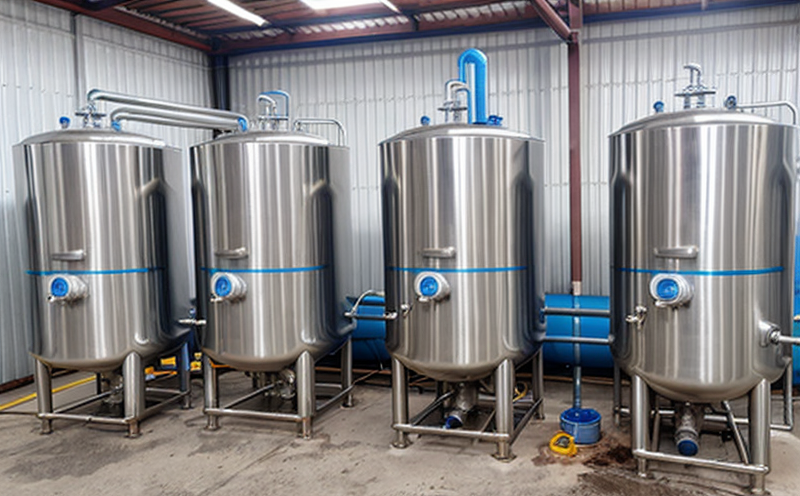ASTM D5464 Bacterial Growth Potential Test in Cooling Water
The ASTM D5464 bacterial growth potential (BGP) test is a critical tool for assessing the risk of biofilm formation and subsequent Legionella or pseudomonas infections within cooling water systems. This standardized procedure evaluates the presence of viable bacteria that can multiply under specific environmental conditions, thereby highlighting areas where enhanced treatment might be necessary to maintain system integrity.
Cooling water systems are vital components in numerous industrial processes, from power generation to manufacturing. They play a crucial role by dissipating heat generated during operations. However, the presence of bacteria and other microorganisms can lead to fouling, corrosion, and the development of biofilms, which not only degrade equipment but also pose health risks.
The ASTM D5464 test specifically targets Legionella pneumophila, Pseudomonas aeruginosa, and other opportunistic pathogens that thrive in warm water environments. By identifying these organisms early, facility managers can implement preventive measures to mitigate potential outbreaks of Legionnaires' disease or other respiratory illnesses.
The methodology involves inoculating a sample of cooling water with a standardized nutrient broth containing the target bacteria. The sample is then incubated under controlled conditions designed to simulate the environmental stresses found within the system. After a specified period, any increase in bacterial count indicates an elevated risk of biofilm formation and subsequent infections.
Understanding the nuances of this test requires knowledge of the specific parameters involved:
- Sample Collection: Samples should be collected from the cooling tower or other relevant points in the water system. Proper aseptic techniques must be employed to prevent contamination.
- Inoculation: The sample is inoculated into a specialized nutrient broth that supports bacterial growth and multiplication.
- Incubation Conditions: Incubation typically occurs at 37°C, which mimics the optimal temperature for many pathogenic bacteria.
- Testing Interval: Testing should be conducted at regular intervals to monitor changes in bacterial growth potential over time.
The results of this test are invaluable for quality managers and compliance officers. It provides a quantitative measure of the risk associated with the current water management practices, enabling informed decisions about treatment strategies. R&D engineers can use these findings to refine their approaches to biofilm control and improve overall system performance.
For procurement teams, ensuring adherence to standards like ASTM D5464 is essential for selecting suppliers who prioritize quality and safety in their products and services. By implementing this test, organizations not only enhance operational efficiency but also contribute significantly to public health by reducing the risk of waterborne illnesses.
Benefits
The ASTM D5464 BGP test offers numerous benefits that are critical for maintaining efficient and safe cooling water systems:
- Prevent Biofilm Formation: By identifying potential bacterial growth early, this test helps prevent the formation of biofilms, which can lead to significant equipment damage.
- Increase Operational Efficiency: Eliminating the risk factors associated with bacteria and pathogens enhances the overall performance of cooling systems.
- Enhance Safety: Reducing the likelihood of waterborne infections contributes to a safer work environment, protecting employees from respiratory illnesses like Legionnaires' disease.
- Compliance Assurance: Regular testing ensures that facilities meet regulatory requirements and industry best practices.
Beyond these immediate benefits, the test also fosters continuous improvement by providing data-driven insights into water management strategies. This information is crucial for long-term sustainability and operational excellence within industrial settings.
Customer Impact and Satisfaction
The ASTM D5464 BGP test has a direct positive impact on customer satisfaction by ensuring that cooling water systems are safe, efficient, and compliant with industry standards. Facilities that undergo this testing can expect:
- Improved Reputation: Demonstrating commitment to safety and quality enhances the reputation of the facility among stakeholders.
- Increased Customer Trust: Compliance with recognized tests like ASTM D5464 builds trust with clients and partners.
- Saved Costs: Preventing biofilm formation and infections reduces maintenance costs and potential legal liabilities.
The test also contributes to long-term sustainability by promoting responsible water management practices. This not only benefits the immediate environment but also supports global environmental goals.
Environmental and Sustainability Contributions
The ASTM D5464 BGP test plays a crucial role in environmental sustainability by:
- Promoting Water Efficiency: By preventing biofilm formation, the test helps reduce water waste.
- Minimizing Chemical Use: Enhanced treatment strategies can lead to reduced chemical consumption and lower environmental impact.
- Reducing Carbon Footprint: Efficient cooling systems contribute to overall energy savings, thereby reducing greenhouse gas emissions.
In addition, the test supports broader sustainability initiatives by fostering a culture of continuous improvement and best practice adherence within industrial operations.





